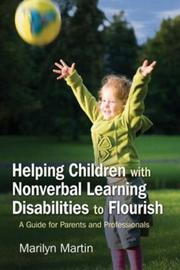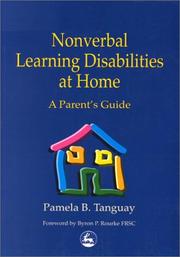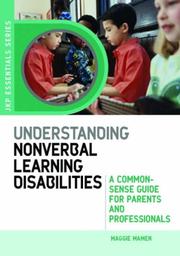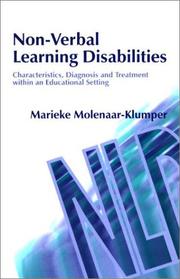| Listing 1 - 8 of 8 |
Sort by
|

ISBN: 128110535X 9786611105358 1846426197 1435602994 9781435602991 9781281105356 9781846426193 9781843108580 Year: 2007 Publisher: London Philadelphia Jessica Kingsley Publishers
Abstract | Keywords | Export | Availability | Bookmark
 Loading...
Loading...Choose an application
- Reference Manager
- EndNote
- RefWorks (Direct export to RefWorks)
Marilyn Martin's book Helping Children with Nonverbal Learning Disabilities to Flourish is an exciting and essential new addition to the literature. … Martin shines in her ability to match interventions to a broad range of problems and examples abound in every chapter. Clear, concise, and detailed explanations are given so that the interventions can be applied skillfully. … Each intervention is presented in a terrifically useful and usable format that includes the problem, strengths available, proposed solution, how the solution can be generalized, the goal of the intervention, a
Book
ISBN: 1784502138 9781784502133 Year: 2016 Publisher: Jessica Kingsley Publishers
Abstract | Keywords | Export | Availability | Bookmark
 Loading...
Loading...Choose an application
- Reference Manager
- EndNote
- RefWorks (Direct export to RefWorks)
Nonverbal learning disabilities. --- Learning disabilities. --- Learning disorders --- Cognition disorders --- Disabilities --- Minimal brain dysfunction in children --- NLD (Nonverbal learning disabilities) --- Nonverbal learning disorders --- NVLD (Nonverbal learning disabilities) --- Learning disabilities

ISBN: 1846422701 0585488347 9780585488349 9781846422706 9781853029400 1853029408 Year: 2001 Publisher: London Philadelphia Jessica Kingsley Pub.
Abstract | Keywords | Export | Availability | Bookmark
 Loading...
Loading...Choose an application
- Reference Manager
- EndNote
- RefWorks (Direct export to RefWorks)
This book explores the problems children with NLD may face, and provides strategies for parents to help them cope and grow, from preschool age through their challenging adolescent years. The author provides solutions to the everyday challenges of the disorder, from early warning signs and self-care issues to social skills and personal safety.
Learning disabled children --- Nonverbal learning disabilities --- Parents of children with disabilities --- Social skills in children --- Child psychology --- NLD (Nonverbal learning disabilities) --- Nonverbal learning disorders --- NVLD (Nonverbal learning disabilities) --- Learning disabilities --- Children with mental disabilities --- Home care

ISBN: 1281143324 9786611143329 184642674X 9781846426742 6611143327 9781843105930 1843105934 9781281143327 Year: 2007 Publisher: London Philadelphia Jessica Kingsley Publishers
Abstract | Keywords | Export | Availability | Bookmark
 Loading...
Loading...Choose an application
- Reference Manager
- EndNote
- RefWorks (Direct export to RefWorks)
This easy-to-read guide offers a complete overview of Nonverbal Learning Disabilities (NLDs) and the wide variety of symptoms that different types of NLD present. Maggie Mamen enables readers to select the most relevant strategies for coping with and managing their particular symptoms. She provides a wealth of practical advice on key skills such as developing written and verbal communication, understanding social clues, managing behaviour, self-regulation and improving organization. She also covers relevant teaching methods for the classroom. This practical and accessible introduction is an essential guide for those families and professionals working with children and adults with NLDs. - Publisher.
Nonverbal learning disabilities. --- Educación especial --- Trastornos del aprendizaje --- Libros electronicos --- NLD (Nonverbal learning disabilities) --- Nonverbal learning disorders --- NVLD (Nonverbal learning disabilities) --- Learning disabilities --- Learning disabilities. --- Learning disorders --- Cognition disorders --- Disabilities --- Minimal brain dysfunction in children

ISBN: 1283904438 1846423473 0585481326 9780585481326 9781846423475 9781843100669 1843100665 1843100665 9781283904438 Year: 2002 Publisher: London Philadelphia Jessica Kingsley Publishers
Abstract | Keywords | Export | Availability | Bookmark
 Loading...
Loading...Choose an application
- Reference Manager
- EndNote
- RefWorks (Direct export to RefWorks)
The author provides an overview of the opinions expressed about NLD. She describes the cognitive, psychometric, socio-emotional and visual aspects, and also discusses how it can be diagnosed and how it associates itself with other conditions. She concludes by suggesting practical treatment strategies that can be applied at home and in school.
Nonverbal learning disabilities. --- Learning disabilities. --- Learning disabled children. --- Social skills in children. --- Child psychology. --- Behavior, Child --- Child behavior --- Child study --- Children --- Pediatric psychology --- Child development --- Developmental psychology --- Child psychology --- Children with mental disabilities --- Learning disorders --- Cognition disorders --- Disabilities --- Minimal brain dysfunction in children --- NLD (Nonverbal learning disabilities) --- Nonverbal learning disorders --- NVLD (Nonverbal learning disabilities) --- Learning disabilities --- Psychology
Book
ISBN: 3030561089 3030561070 Year: 2020 Publisher: Cham, Switzerland : Springer,
Abstract | Keywords | Export | Availability | Bookmark
 Loading...
Loading...Choose an application
- Reference Manager
- EndNote
- RefWorks (Direct export to RefWorks)
This unique volume explores issues related to working with children who have nonverbal learning disability (NVLD). It examines how a child’s psychology – thoughts, feelings, beliefs – affects his or her functioning and learning. In addition, the book addresses how a child’s experiences are processed through individual personality, psychology, culture, environment and economic circumstances, and family dynamics. Using these psychological organizing principles, the book describes how to work most effectively with young patients with NVLD. It offers a new model and definition for understanding NVLD, emphasizing its core deficit of visual-spatial processing. In addition, this book addresses efforts to rename NVLD to developmental visual-spatial disorder (DVSD). It describes the 11 possible subtypes as including a primary deficit in visual-spatial processes and impairment in several additional functional domains, including executive functioning, social/emotional deficits, academic achievement, and motor coordination. The book highlights the need for psychologically minded treatment and provides specific intervention guidelines. It details how to conduct the intake process and create a treatment plan and team and offers practical suggestions for working with a patient’s family members. In addition, the book addresses the importance of working with a consistent psychological theory, such as control mastery theory (CMT). It describes the Brooklyn Learning Center Model for treating NVLD and offers guidelines for interventions to support patients academically. The book provides a comprehensive approach to the neuropsychological assessment of NVLD as well as examples of visual-spatial, sensory perception, executive functioning, academics, social/emotional deficits and motor coordination interventions, and all forms used to gather information from patients. Key areas of coverage include: Definition of nonverbal learning disability (NVLD). Efforts toward inclusion in the Diagnostic and Statistical Manual (DSM) and for renaming it to a developmental visual-spatial disorder (DVSD) Guide to general diagnostic testing and assessment. Developing a treatment plan and team for NVLD patients. NVLD therapy and tutoring priorities. NVLD and Developmental Visual-Spatial Disorder in Children is an essential reference for clinicians, therapists, and other professionals as well as researchers, professors, and graduate students in school and clinical child psychology, special education, speech-language therapy, developmental psychology, pediatrics, social work as well as all interrelated disciplines.
Child psychology. --- School psychology. --- Child psychiatry. --- Speech pathology. --- Clinical psychology. --- Developmental psychology. --- Pediatrics. --- Child and School Psychology. --- Child and Adolescent Psychiatry. --- Speech Pathology. --- Clinical Psychology. --- Developmental Psychology. --- Paediatrics --- Pediatric medicine --- Medicine --- Children --- Pediatric psychiatry --- Child mental health services --- Pediatric neurology --- Psychiatry --- Psychology, School --- Psychology, Applied --- Behavior, Child --- Child behavior --- Child study --- Pediatric psychology --- Child development --- Developmental psychology --- Development (Psychology) --- Developmental psychobiology --- Psychology --- Life cycle, Human --- Psychological tests --- Defective speech --- Disorders of speech --- Speech, Disorders of --- Speech defects --- Speech pathology --- Communicative disorders --- Diseases --- Health and hygiene --- Mental disorders --- Nonverbal learning disabilities. --- NLD (Nonverbal learning disabilities) --- Nonverbal learning disorders --- NVLD (Nonverbal learning disabilities) --- Learning disabilities
Book
ISBN: 1441982124 1441982132 Year: 2011 Publisher: New York : Springer,
Abstract | Keywords | Export | Availability | Bookmark
 Loading...
Loading...Choose an application
- Reference Manager
- EndNote
- RefWorks (Direct export to RefWorks)
Although it has yet to be recognized by the American Psychiatric Association’s Diagnostic and Statistical Manual (DSM), nonverbal learning disabilities (NVLD) in children are a growing concern. NVLD are receiving increased attention from researchers as well as from clinicians encountering these conditions in their young clients. At the same time, reliable information on effective interventions for NVLD has lagged behind this interest. Nonverbal Learning Disabilities in Children: Bridging the Gap Between Science and Practice offers a well-rounded understanding of NVLD, placing it within the context of other developmental disorders, most notably high-functioning autism and Asperger’s syndrome. The most current genetic, environmental, and neurobiological theories of and research into the causes of NVLD (e.g., the “white matter model”), in-depth diagnostic methods, and quality interventions are examined. Using an evidence-based approach, this groundbreaking volume: Conceptualizes NVLD as a disorder with subtypes. Differentiates between diagnostic criteria for NVLD and Asperger’s Syndrome. Analyzes the co-occurrence of NVLD with other developmental disabilities and psychological disorders. Provides a comprehensive psychoeducational assessment model. Describes efficacious treatments and supports their empirical validation. Offers guidelines for sustaining treatment gains through effective collaboration of school personnel and family members. Nonverbal Learning Disabilities in Children is a must-have reference for researchers, practitioners, and graduate students in school and clinical child psychology, education, speech-language therapy, and other disciplines and professions involved in identifying and treating children with NVLD.
Adolescent. --- Child. --- Learning disorders. --- Nonverbal communication -- Psychology. --- Nonverbal learning disabilities. --- Social behavior. --- Social skills in children. --- Nonverbal learning disabilities --- Social skills in children --- Behavioral Sciences --- Age Groups --- Communication Disorders --- Communication --- Mental Disorders Diagnosed in Childhood --- Behavior --- Persons --- Behavior and Behavior Mechanisms --- Mental Disorders --- Neurobehavioral Manifestations --- Information Science --- Behavioral Disciplines and Activities --- Named Groups --- Neurologic Manifestations --- Psychiatry and Psychology --- Signs and Symptoms --- Nervous System Diseases --- Diseases --- Pathological Conditions, Signs and Symptoms --- Nonverbal Communication --- Learning Disorders --- Psychology --- Social Behavior --- Developmental Disabilities --- Adolescent --- Child --- Social Sciences --- Medicine --- Health & Biological Sciences --- Pediatrics --- Learning disabled children. --- NLD (Nonverbal learning disabilities) --- Nonverbal learning disorders --- NVLD (Nonverbal learning disabilities) --- Psychology. --- Education. --- Social work. --- Clinical psychology. --- Psychotherapy. --- Counseling. --- Child psychology. --- School psychology. --- Developmental psychology. --- Child and School Psychology. --- Social Work. --- Education, general. --- Developmental Psychology. --- Clinical Psychology. --- Psychotherapy and Counseling. --- Children with mental disabilities --- Learning disabilities --- Psychology, clinical. --- Applied psychology. --- Applied psychology --- Psychagogy --- Psychology, Practical --- Social psychotechnics --- Benevolent institutions --- Philanthropy --- Relief stations (for the poor) --- Social service agencies --- Social welfare --- Social work --- Human services --- Development (Psychology) --- Developmental psychobiology --- Life cycle, Human --- Counselling --- Helping behavior --- Psychology, Applied --- Clinical sociology --- Interviewing --- Personal coaching --- Social case work --- Therapy (Psychotherapy) --- Mental illness --- Mental health counseling --- Psychiatry --- Psychological tests --- Children --- Education, Primitive --- Education of children --- Human resource development --- Instruction --- Pedagogy --- Schooling --- Students --- Youth --- Civilization --- Learning and scholarship --- Mental discipline --- Schools --- Teaching --- Training --- Psychology, School --- Behavior, Child --- Child behavior --- Child study --- Pediatric psychology --- Child development --- Developmental psychology --- Treatment --- Education
Book
ISBN: 1489987762 1461461782 1461461790 Year: 2013 Publisher: New York : Springer,
Abstract | Keywords | Export | Availability | Bookmark
 Loading...
Loading...Choose an application
- Reference Manager
- EndNote
- RefWorks (Direct export to RefWorks)
Children with nonverbal learning disabilities (NVLD) have needs that can take many forms and may, over time, require consultation and collaboration with professionals from several fields. Given that multiple specialists may be involved in working with children with NVLD – as well as the array of treatment variables – even seasoned practitioners may find themselves in confusing situations. Treating NVLD in Children takes a developmental view of how the problems and needs of young people with nonverbal learning disabilities evolve and offers a concise guide for professionals who are likely to contribute to treatment. Expert practitioners across specialties in psychology, education, and rehabilitative therapy explain their roles in treatment, the decisions they are called on to make, and their interactions with other professionals. Collaborative interventions and teamwork are emphasized, as are transitions to higher learning, employment, and the adult world. Among the book’s key features are: A new four-subtype model of NVLD, with supporting research. A brief guide to assessment, transmitting results, and treatment planning. Chapters detailing the work of psychologists, therapists, coaches, and others in helping children with NVLD. Material specific to improving reading, writing, and mathematics. Overview of issues in emotional competency and independent living. An instructive personal account of growing up with NVLD. Treating NVLD in Children: Professional Collaborations for Positive Outcomes is a key resource for a wide range of professionals working with children, including school and clinical child psychologists; educational psychologists and therapists; pediatricians; social workers and school counselors; speech and language therapists; child and adolescent psychiatrists; and marriage and family therapists.
Developmental psychology. --- Educational psychology. --- Pediatrics. --- Philosophy (General). --- Psychiatry. --- Social work. --- Learning disabilities --- Communication Disorders --- Mental Disorders Diagnosed in Childhood --- Neurobehavioral Manifestations --- Mental Disorders --- Neurologic Manifestations --- Psychiatry and Psychology --- Nervous System Diseases --- Diseases --- Developmental Disabilities --- Learning Disorders --- Social Sciences --- Psychology --- Treatment --- Nonverbal learning disabilities --- Learning disabled children. --- Treatment. --- NLD (Nonverbal learning disabilities) --- Nonverbal learning disorders --- NVLD (Nonverbal learning disabilities) --- Psychology. --- Education --- Families. --- Families --- Child psychology. --- School psychology. --- Child and School Psychology. --- Educational Psychology. --- Social Work. --- Family. --- Social aspects. --- Children with mental disabilities --- Medicine and psychology --- Mental health --- Psychology, Pathological --- Benevolent institutions --- Philanthropy --- Relief stations (for the poor) --- Social service agencies --- Social welfare --- Social work --- Human services --- Paediatrics --- Pediatric medicine --- Medicine --- Children --- Psychology, Educational --- Child psychology --- Development (Psychology) --- Developmental psychobiology --- Life cycle, Human --- Health and hygiene --- Education—Psychology. --- Families—Social aspects. --- Family --- Family life --- Family relationships --- Family structure --- Relationships, Family --- Structure, Family --- Social institutions --- Birth order --- Domestic relations --- Home --- Households --- Kinship --- Marriage --- Matriarchy --- Parenthood --- Patriarchy --- Psychology, School --- Psychology, Applied --- Behavior, Child --- Child behavior --- Child study --- Pediatric psychology --- Child development --- Developmental psychology --- Social aspects --- Social conditions
| Listing 1 - 8 of 8 |
Sort by
|

 Search
Search Feedback
Feedback About UniCat
About UniCat  Help
Help News
News